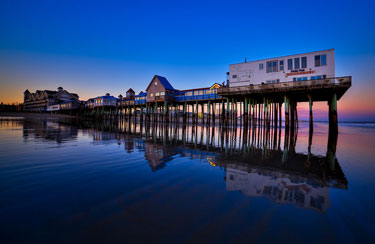November 2013 | view this story as a .pdf
It’s the stuff that dreams, lawsuits, and disasters are made of.
By Colin W. Sargent
 In the ‘movie’ version, six guys–Bradley Cooper, Zack Galifianakis, Vince Vaughn, Luke Wilson, Owen Wilson, and Robert Downey, Jr.–find themselves marooned in the deserted Casino, engulfed by waves. A monster storm has ripped 300 feet of the 1,770-foot pier connecting it to shore so now the dance hall is a crazy electric island, wires sparking and snapping, night closing in. Just six men, an empty dance floor…and no smart phones. Each man’s life is laid bare as they huddle for a long dark night of the soul. Think Hangover IV meets Lost in the Funhouse.
In the ‘movie’ version, six guys–Bradley Cooper, Zack Galifianakis, Vince Vaughn, Luke Wilson, Owen Wilson, and Robert Downey, Jr.–find themselves marooned in the deserted Casino, engulfed by waves. A monster storm has ripped 300 feet of the 1,770-foot pier connecting it to shore so now the dance hall is a crazy electric island, wires sparking and snapping, night closing in. Just six men, an empty dance floor…and no smart phones. Each man’s life is laid bare as they huddle for a long dark night of the soul. Think Hangover IV meets Lost in the Funhouse.
Or is it No Exit?
The date was April 30, 1909. The real-life stars of this adventure were OOB locals Edward Charland and John Freeman, and Biddeford residents John Foss, John Hayes, Charlie Watson, and Jim Farley. In “Stranded at the severed end of Old Orchard Beach Pier,” reporter Sharon Cummins does a fine job chronicling the event on her blog, spiced with dispatches from the New York Times and the Portsmouth Herald.
The human drama went global. With just a single black electrical wire connecting the stranded men across the storm-tossed waves to what was left of the rest of the pier, the isolated men were doomed to fight a ballroom with a mind of its own.
The six working stiffs had originally been sent out to survey devastation from a March 26 storm. The objective: Lash broken timbers together, snuff out the electrical danger, and rescue the rest of the casino so it could be relocated at the end of a shorter, wooden pier.
Now, out of nowhere, the sky had blackened. Massive waves ripped their boat from its ties as “the workmen watched helplessly as their tender…was carried away.”
Night swept in, and things got cold. Illuminated by strings of incandescent lights, a throng of 100 kept a vigil on the beach. Geeks were consulted to find a high-tech solution to help these hapless “castaways” across the deadly waves.
“Several rescue parties were formed, but each turned back before reaching the castaways.” The next morning, the icy realization took hold: Our heroes would continue to be “marooned with no prospect of relief until the tempest subsides.”
What would you have done if you were trapped out there? Huddled in empty chairs among moving floorboards while the storm pounded outside? “They hadn’t had food or water for 24 hours. Finally someone noticed the electrical wire still connecting the two parts of the pier. Cans were filled with food and water, sealed up and attached to the wire. When the men at the casino got the signal they pulled the cans to their desert island of steel and wood. This bought some time but rescue was still impossible. The men took shelter in the casino and tore up some of the floorboards for a fire while they waited for the weather to break.”
Before Fletcher’s Neck Coast Guard Station, seven miles across the bay, was able to respond to a wire to send a lifeboat over, a “hearty French-Canadian boatman, Eugene Bill, dragged his dory down to the water’s edge, and shoving out, grabbed a single oar to guide her–canoe fashion–through ten foot waves.”
Not a big talker, this Eugene Bill. This ghostly figure would be played by Sam Elliott.
With the casino looming 20 feet above the surface of the water, “Bill had a well-constructed rope ladder with him, which he was able to toss to one of the men on the pier.” Riding from wave after huge wave, the dory lifted until he was eye-to-eye with the castaways. Then the bottom fell out of the wave and he’d have to start again. “The waves would allow him to remain but a second; else they’d dash his little dory to pieces against the iron pilings of the pier,” reported the New York Times.
“In this way, Eugene Bill rescued three of the men and then went back out a second time to rescue those remaining at the casino. Thanks to him, all six of the workmen were landed safe and sound after being stranded for 60 hours a third of a mile out to sea.”
Wondrous strange, this incident. But still, it’s just a wonder among wonders.
8th Wonder of the world
When the ribbon was cut for this metal marvel on July 2, 1898, it was a “global cultural icon,” at 1,825 feet the longest steel pier in the world, created by Berlin Iron Bridge Co. A bargain at $38,000, it lunged toward a larger share of the tourist market like a giant tuning fork for all of New England. Less than 10 years earlier, Gustave Eiffel had stunned with his iron-lattice tower on the Seine, a similar wonder of the world. The Pier was nearly three times the size, aimed directly into the waves.
Just as tourists flood to Portland and L.L. Bean today, “Old Orchard Beach was the place to go, from New York up. The Canadians would certainly come down to vacation for the summer,” says Jeffrey A. Scully, author of The Old Orchard (Arcadia, 2012).
Mainers will be amused to learn that the pier was so long the ballroom at the end of it wasn’t even in Old Orchard Beach. “It was in Saco,” Scully laughs. “The Casino had to pay taxes in Saco and not Old Orchard Beach.” Built to host a capacity of 5,000 dancers (the winter population of OOB barely crests 9,000), “it was kind of an island unto itself.” Even today, “the town line extends only a very short way out from the low tide marker,” so the pier continues to venture into Saco waters. “Just 15 or so years ago, there were still attorneys kind of wrangling to get all of that to be OOB.”
The distinction of being the longest steel pier in the world was short-lived. “Barely six months or so,” Scully says, “in December of that year, a storm shortened the pier.” In fact, Mother Nature can’t resist remodeling it. The site oobpier.com ticks off the disasters: “In August of 1907, a fire destroyed the entrance. Once again, the pier was rebuilt in 1908 only to have one of the pavilions swept away by the great storm of March, 1909. This storm caused extensive damage and the casino was shortened by 1,000 feet from its original length of 1,825 feet.” The storm of 1978 completely smashed the casino, turning it into matchsticks, never to return. Now the pier was just 400 feet. But before then…
Let’s Dance
“The middle of the century saw the heyday of the Pier Casino Ballroom,” oobpier.com says. “The Ballroom was noted for its moving picture shows and live entertainment, featuring acts such as Frank Sinatra, Xavier Cugat and Benny Goodman.”
As impressive as this short list is, it neglects to mention Louis Armstrong, Count Basie, Lionel Hampton, and Duke Ellington. Which all but brings up the question, regarding black musicians: Was it okay to play here, just not okay to stay here?
“I could only guess where Duke Ellington stayed,” Jeffrey Scully says. “There used to be a hotel at the top of the hill, right where Rite Aid is now, on Seaside Avenue. It was a huge, huge hotel, and that’s where quite a few of the famous people stayed…I don’t think there was an atmosphere of, ‘It’s okay to play here, but not to stay here,’ particularly with the bands of the late 1930s and early 1940s at Old Orchard Beach.
“In the 1920s, there was a really strong presence of the KKK in Maine. Circa September 1927, that organization was run out of town [in Old Orchard]. There was a big KKK rally at the Burns School. They marched to City Hall, then tried to go into Biddeford, but the Biddeford fire department actually hosed them down and dispersed them.”
Actually, the guest house where Duke Ellington stayed is gaining well deserved attention, thanks to its inclusion in the National Register of Historic Places in 2004 and a March 15, 2010, newspaper story by Kelley Bouchard of the Portland Press Herald that identifies a guest book spanning 1923 to 1993 that carries over 3,000 names of African-American visitors to a place nicknamed “110,” the house of Rose Cummings and family. The ramshackle Shingle Style house still stands at 110 Portland Avenue. Of the signatures in the guest book, Bouchard writes, “Some were big names, including jazz band leader Duke Ellington and Harlem Renaissance poet Countee Cullen…” Also Cab Calloway, Count Basie, and Lionel Hampton. “Others were doctors, judges, newspaper publishers, university employees, religious leaders and ordinary folk. All of them sought a hospitable place to enjoy summer on the Maine coast where the color of their skin didn’t matter…The Sampson Center for Diversity in Maine recently acquired the ink-splotched registry for the African-American Collection at the Glickman Family Library at the University of Southern Maine in Portland. The 182-page ledger, purchased from a Cummings family member for an undisclosed price, offers a unique glimpse into the social lives of blacks in Maine and the United States during the last century.”
Of “110,” the Lewiston Sun Journal reported in 2004 that “Accommodations were Spartan, but the hospitality was great. So was the food–lobster salads, fried chicken, and every Sunday morning, the proprietor’s beloved mackerel and beans.”
In an interview with Portland Magazine, musician Mark Finks remembers, “As a kid, when I used to haunt Old Orchard Beach Pier to hear the big bands, I discovered something interesting. Outside of Maine, whenever the Duke Ellington Orchestra traveled, say, in the South, they stayed in the Pullman [overnight sleeping] cars so no unpleasant hotel policies could crop up. After they’d play on a given night, they’d come back and the train would roll out of town. Not so in Old Orchard Beach! He was warmly welcomed here. Whenever he performed at the pier, Ellington stayed with a family named Cummings in a house a block from the beach. Mercer Ellington, Duke’s son, encouraged the Cummings’ daughter, Ann Cummings Searcy, to perform, and she did! Throughout her life she had an extraordinary singing ability we’d compare to Billie Holiday–without the drugs. She had a very pure, beautiful voice. The last time I heard, she was at the Barron Center.”
Searcy passed away in 2006. She is important for at least one more reason. A lifelong educator, Ann Cummings Searcy, a graduate of Gorham State Teachers College (now USM), was the first African-American ever to earn a teaching certificate in Maine. Friend and blogger Agy Wilson (read her elegy on Searcy: http://tinyurl.com/nx6oqqr) reveals that W.E.B. DuBois also stayed at “110,” and that the rates were $12 per week. Of Countee Cullen, Wilson writes, “Mr. Cullen had even dedicated his book My Lives and How I Lost Them to ‘Pumpkin Cummings of Old Orchard Beach’–Annie’s cat.”
Female stars to grace the pier include “the Clooney Sisters, Helen Forrest, Doris Day, Billie Holiday, Lena Horne, Abbe Lane, Peggy Lee, Helen O’Connell, Jane Russell, Dinah Shore, Keely Smith, Jo Stafford, Kay Starr, and Margaret Whiting, all featured with named big bands,” according to Old Orchard Beach, by Daniel E. Blaney.
Close Encounters of the Legal Kind
Sure as it draws Nor’easters, the Pier is a magnet for Byzantine lawsuits, carrying winds more far-reaching than the most withering of storms. We asked the Maine School of Law to distill the twisting, turning, vituperative affair surrounding just one figure, Catherine Duffy Petit, who was forced to sell the pier at foreclosure auction in 1989 and was later given a 15-year, eight-month sentence in a related matter. Their initial reply: “De novo?” Because it’s impossible to fairly describe these multi-decade legal snaggles from scratch. Peel away the layers and you’ll find long, dark splinters. Among many internet sites providing further reading about these trials are: http://tinyurl.com/lkc4cmt; http://www.greatmaine.com/justicewhen/verdict.html.
At the foreclosure auction, Paul Golzbein, who like Petit has a love for The Pier and comes from a family deeply connected with it, prevailed above the smoke and mirrors of the foreclosure auction to become the new owner, for a figure of roughly $1.44 million.
Golzbein takes us inside the negotiations: “That number [$1.44M] is about right,” he says. “During the auction, the Lewis family, who had first option to The Pier [the late George I. Lewis of Portland, for whom the Cumberland County Civic Center Auditorium is named, held Petit’s mortgage], bought it back. [Lewis’s son David] had to buy it from himself at auction so he could get the paper back clean” and clear creditors. “Then he met with five people. I was one of them.”
At the end of the meeting, “we shook hands, and after the closing five weeks later,” Golzbein walked to the end of The Pier and took a deep breath.
New Dreams
Even if, as James Joyce writes, a pier is nothing but “a disappointed bridge,” the new owner had completed a mythic circle.
“My great-grandfather Nathan Wolfe started in Old Orchard in 1880,” Golzbein says. “He had a little wagon and basket, selling souvenirs at the train station. When The Pier was built, he said, ‘I’m moving over here.’ Everybody said, ‘You’re out of your mind.’ We’ve been on that pier since the day it was built. The Pier’s gone through many changes. The statement point has always been,” as though reaching out for a dream, “at the end of the pier where the Casino is. Right now I’m trying to recreate it, extend it by 400 feet (from 500 to 900 feet), and/or put a 200-foot casino boat at the very end as an entertainment package. Three stories tall.” Why shouldn’t The Pier contemplate a spectacle among spectacles?
“Did you know Joseph P. Kennedy came here many summers? He stayed at Hotel Velvet that burned down in front of The Pier,” Golzbein says. It goes to show: “Old Orchard is the busiest summer resort in Maine. Bar none.” With a winter population that dwindles below 9,000 (even the Downeaster suspends its service from October 15 until April), “we see close to one million people in 90 days: the Boston aristocrats, the Canadians. We’re working closely with the Governor and a couple of Democrat senators to get it back to its international prominence.”
Though the underpinnings of the future are now wood, not steel. “I think it was in 1907 that they changed to wooden pilings, when the middle of the pier collapsed,” Golzbein says. “Right now, it has more pilings than it even needs. I have an architect that comes every year. The engineer has told me, ‘Jesus, Paul, you have pilings every 20 feet when all you need is 40.’ It’s further strengthened by criss-crosses. ‘Well,’ I said, ‘we don’t want this one going down.’
“The Pier is now designed for a 100-year storm. We actually had what the meteorologists called a ‘100-year-storm’ a few years ago, remember? I walked out on The Pier to feel the weather, with white waves rolling right underneath. It was kind of cool walking it. The water would come up between the cracks, but the pier was perfect, performing as advertised. How do you know precisely how to build a pier to withstand, exactly, a 100-year storm? It’s like the Incas. Who would think of how to make a calendar? Leap year–figure that one out.
“I employ 180 people here,” Golzbein, who with his brother David also owns and operates York’s Wild Kingdom, says, “and I feel a sense of responsibility and personal history. Let me tell you what The Pier is. A fellow surprised me by telling this to me once. ‘It’s the economic engine that runs the downtown district.’ Without the pier, OOB is just another town with a beach.”
Probing the darkness, how many ways can the end of a pier tantalize, and what does our attraction to it say about us? “I used to have a dance club upstairs at the end of The Pier,” Golzbein says. “It was called the Big Kahuna. Then we came up with Lindbergh’s Landing. That’s what the dance club is upstairs. Also a banquet center. Just walk up to our balcony…look out our glass windows. You’re staring out…toward England!”
Another man who is a force around The Pier is George Kerr, who owns many of the businesses that spill like conversation into the shoreline around The Pier’s mouth. These interstices of wood and hammered hopes might as well be his North Star, pointing the way to the future. “A guy like me, that’s why I’ve kept my roots in Old Orchard Beach. I was a member of the Beautification and Revitalization Committee in the 1980s, adding brick sidewalks” and providing a clean, clear view of how to develop this singular spot into a 21st-century attraction. “The way we were is what we’re becoming.”
Reverberations & Reflections
For our next surprise, transatlantic aviator Charles A. Lindbergh isn’t the only world figure to launch [see “Lindbergh Slept Here,” Winterguide 2013] memorably from Old Orchard Beach.
Businessweek has ranked philanthropist Bernard Osher, born 1927, the year Lindbergh touched down just feet from The Pier, as the “11th most generous” man in America. Born in Biddeford, the 1948 Bowdoin grad wisely snapped up Palace Playland as a young man near the mouth of The Pier and started his fortune here.
Even Dave the Guesser couldn’t have predicted the heights Osher would reach. Having made it in Maine, he took on California and became a founding director of what would become Wachovia Corp. Another smart move on Osher’s part was to buy Butterfield and Butterfield, the famous San Francisco auction house, and sell it to eBay in 1999. In 2007, Businessweek credited him with having given $805 million to “arts, educational, and social services in his life.”
World on a string
In a downsizing world, Palace Playland now astonishes by identifying itself as “The only beachfront amusement park in New England.” You can learn this via two websites, in English and French. If you’ve never been there, we dare you not to go there. Something deep in us can’t resist a little cotton candy, made tart with wistfulness.
Why has this sunny spot always had the world on a string? Even the name Old Orchard carries a mythic allure, says poet X. J. Kennedy from his home in Lexington, Massachusetts. (Kennedy’s real name is Joseph Kennedy, but he didn’t want to be confused with Ambassador Joseph P. Kennedy of Hyannisport, so he added the X factor.) “Oh, lord,” he says. “I wrote [the poem “The Kite That Braved Old Orchard Beach”] 30 years ago, maybe 25, when our kids were young and we came up to visit a couple of times. Thanks for caring about the poem. Sure, you can publish it.”
The Kite That Braved Old Orchard Beach
The kite that braved Old Orchard Beach
But fell and snapped its spine
Hangs in our attic out of reach,
All tangled in its twine.
My father says, “Let’s throw it out,”
But I won’t let him. No,
There has to be some quiet spot
Where cracked up heroes go.
(The Kite That Braved Old Orchard Beach, Year-Round Poems for Young People by X. J. Kennedy, Margaret K. McElderry Books, NY 1991)
Dave the Guesser
From 1937 on, Dave Glovsky was as essential to Palace Playland visitors as Pier fries. His secrets for guessing a visitor’s job? “Seven out of ten people with sweep-second watches are in the medical field, especially nurses. Truck drivers have two rows of calluses from the steering wheel; carpenters have calluses only on the hand they use on their tools. Welders often have burns on their arms. Look for cuts on butchers’ hands. To guess someone’s age, make him laugh, then look closely: “Wrinkles first appear under the eyes and on the forehead at age 25. At 30, crows’ feet appear, and at 40, general wrinkling begins. Double chins appear at 45. At 50, the hands begin to wrinkle. At 55, the neck begins to sag. Wrinkles appear around the mouth at 60. At 70, the wrinkles have wrinkles!”
“…Dave guesses either December, February, or July for the month of someone’s birth.”
Above: Dave with Louis Armstrong. Dave also guessed with Duke Ellington, Dion, Jane Morgan, Jimmy Dorsey, The Four Lads, The Four Seasons, Woody Herman, Frank Sinatra, Liberace, Chubby Checker, The Beach Boys, Bobby Vee, Bobby Vinton, Bobby Rydell, The Supremes, Count Basie, Peter, Paul, and Mary, and Abbe Lane.
Source: Robert Norman, “Dave the Guesser, “
Greater Portland Magazine (Summer 1985)





0 Comments